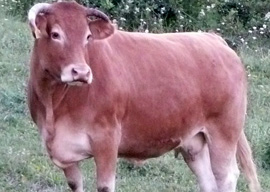
June 17, 2012

Libera
This was an interesting detail that wasn”t in the newspaper article. I have known Giorgio, who is barrel-shaped and pint-sized, for many years so I asked: “Yes, but is it true that you personally went up with carabinieri and the forestale and the vets? Did you actually come face-to-face with that cow?”
“Well, no, not me personally,” he confessed before deftly changing the subject. “But I told everyone: “Quella mucca, non la abbatterò!“ (That cow, I will not slaughter it!)”
I rang Talluto the vet in Predappio from La Petit. He did not go up, either. So who did? No one did. “We held a summit: me, the marisciallo of the carabinieri and the chaps from the forestale, and we decided to wait for a few days,” said the vet.
I now decided that I would try to find the ferocious rebel cow myself in my long-axle Land Rover Defender 110. The Apennines around here are called “colline“ (hills) but are mountainous nonetheless. Once I had located the right mud track in a hamlet beyond Predappio it took me another 20 minutes to drive up from the valley to the remote field where the cow had charged the farmer. The field sat between dense woods and a ravine. Far below, I could see the tiny houses of the hamlet and on the other side of the valley a horizon of jagged peaks. And there in the middle of the field was a cow-sized metal cage brought up no doubt to catch the cow. But there was no cow.
Only birds and crickets pierced the silence. I rang Villa, who had so rudely awakened the sindaco the other day. “I got the cow in the cage but it just tossed it in the air as if it were rubber and then charged me!” he said. “But who knows where is it now?”
So I rang Paganelli, the cow’s owner. “That cow, where is it now?” I asked. “The cow has returned home,” he announced. “Come and have a look for yourself.”
It took me an hour in the Land Rover to reach the rendezvous point at a mill in the next valley beside a river. “Shall I follow you up?” I asked. “Better you come with me,” he said. It was soon clear why. The track up was perilous and steep. Finally, we emerged in a field in which there were about 20 brown cows, French Limousines, used for steak.
“Eccola! (there she is!),” said Paganelli. “Thirteen, eight, sixty-five, that’s her name, or if you want to be technical, IT, for Italy, 040 for Romagna, then 000013865.”
Paganelli claimed that the cow had returned 15 days ago, which was conveniently a long time before the day Villa said he had been charged in his field. “Villa rang me and said: “That cow will kill children and then you”ll be in trouble!” I just told Villa to stop behaving like an idiot and leave my cow and his cows alone and everything would sort itself out. For as our local poet Giosuè Carducci wrote: “As soon as I got to know men, I learned to appreciate animals.””
We drove up close to Libera, who was much smaller than I had imagined and seemed a perfect picture of cow-like innocence. “She comes and she goes,” Paganelli said. “She’s organic. They all are.” Organic? “They eat only organic food and spend their lives, except when there’s snow, roaming around like free-range chickens,” he explained.
But Libera still had a left horn although, yes, to be fair, it was damaged.
Paganelli has 200 of these organic cows. How many of them have damaged left horns, or no left horns at all, and are still out there on the loose? There is no easy answer. As Paganelli says: “My cows, they come and they go; they”re organic.”